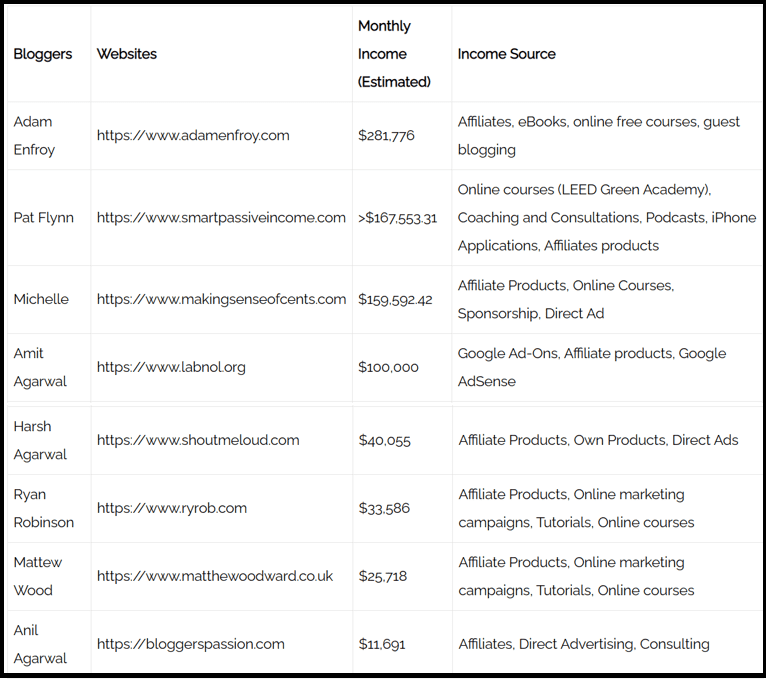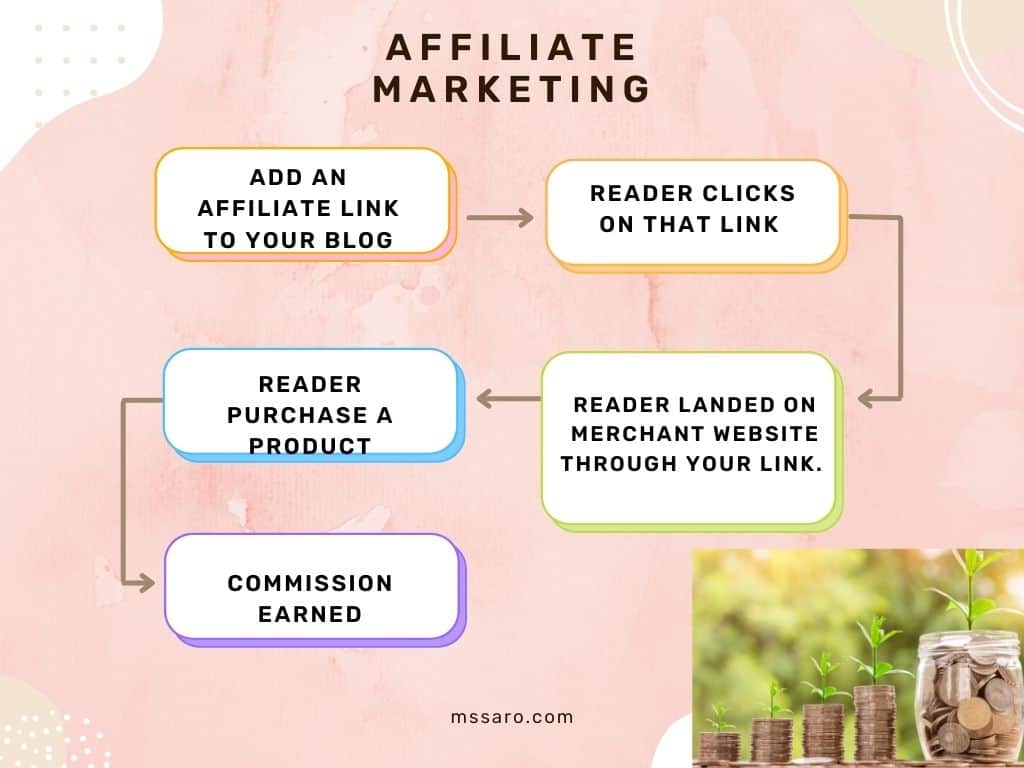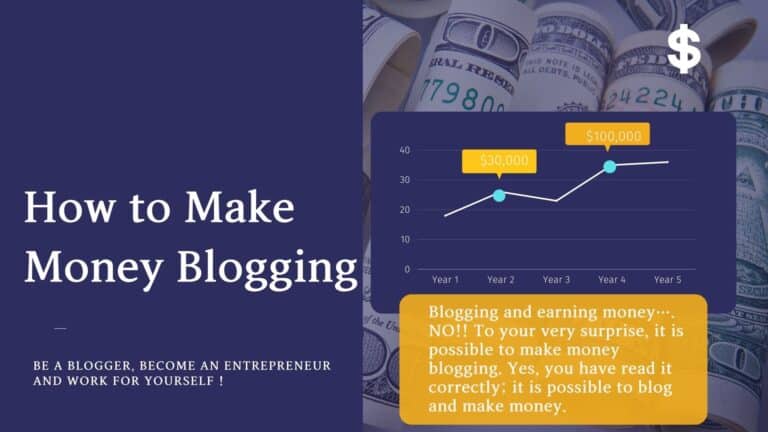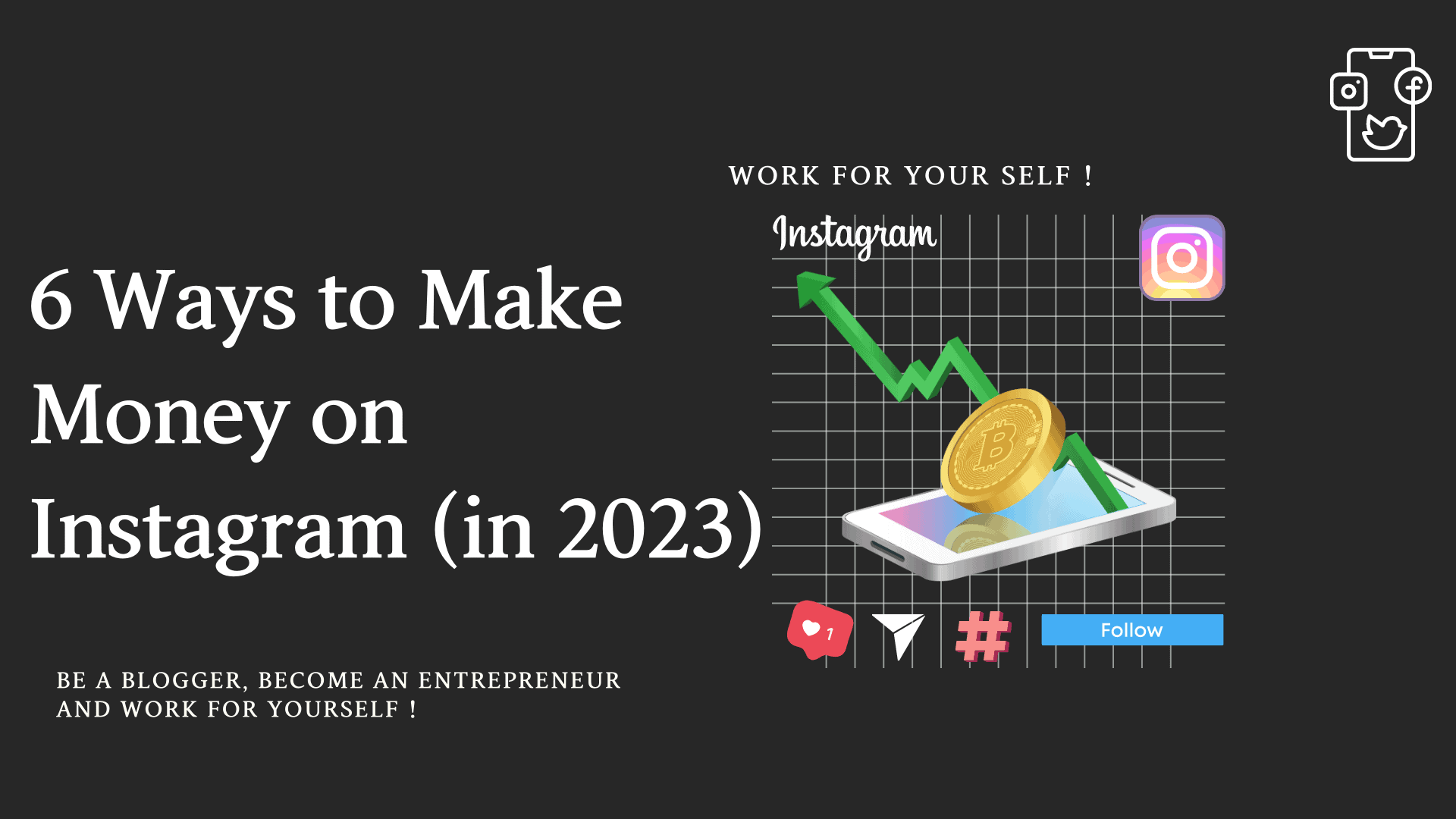Blogging and earning money: Is it possible to earn money from blogging? 🤔 Don’t be surprised. It is very much possible to make money by blogging. You must be wondering how it is possible to make money from blogging.
Don’t worry you will know this just after reading this blog.
Blogging has evolved from a hobby into a lucrative opportunity for those who can harness its power and do it with honesty and hard work.
However, it is claimed that it is not the most straightforward way, but certainly a much better way to earn money while blogging.
Here, I am providing some of the other blogger’s incomes from blogging only to show you the potential of the blogging business.
Always remember there is no shortcut to success.
Table of Contents
ToggleOther Blogger’s Income

Note: Above are the bloggers’ estimated incomes, which may vary.
You have to think and do blogging like a business owner and start monetizing your blog correctly.
Here are some best ways to incorporate blogging and earn money into your business.
Before that, we must know how to start a blog. So here are the steps to start a blogging website.
Steps to Start a Blog and Make Money Blogging
Yes, blogging gives monetization of your blog.
There are many ways to monetize and start your blog.
Some predefined steps to start a blog are as follows:
- Select your blog niche and blog topic.
- Select blogging platform
- Decide domain name and web hosting
- Select the theme of your blog.
- Write your first blog.
- Install WordPress essential settings.
- Promote your blog
- Monetize your blog
With these steps, you will start your blogging journey constructively.
All these prerequisites are essential for starting your blogging website and making money from blogging.
Infographics on How to Make Money from Blogging

How to Make Money with a Blog for Beginners
As a beginner blogger, you can start earning from your blog by following the below-mentioned ways:
1. Google AdSense
Google AdSense is an advertising program offered by Google that allows website owners to display targeted ads on their web pages.
It works on a pay-per-click (PPC) model, meaning you earn revenue every time a visitor clicks on an ad displayed on your website.
The ads served through Google AdSense are contextually relevant to your website’s content, increasing the chances of user engagement and clicks.

The popular and most common way of earning money is through advertisement, i.e., placing ads on your blogging pages.
Ways by which a blogger could earn money through Google AdSense are ‘cost per click (pay per click),’ ‘cost per impression,’ and ‘Cost per Engagement.
Cost per click/ pay per click means you would earn each time the reader clicks on your blog’s ads.
Cost per impression means you would earn a fixed amount based on how many people viewed the ad on your blogging site.
Cost per Engagement means you earn when a reader watches your full video Ads, i.e., the reader is engaged with the Ads, advertised at your blogging site.
The network that could be used for placing these types of ads is
They provide high pay and robust reporting on your blog’s ad performance.
You earn passive income with these contextual advertising networks that quickly approve your quality blog.
Next, you are required to see the eligibility criteria for adding Google AdSense to the blogging site.
The Essential Requirement for Joining Google AdSense
- Must have an active Gmail account
- Your age must be 18 years old.
- Your content must be unique and exciting.
- Your website and content must comply with AdSense policies. AdSense Program policies – Google AdSense Help
It takes hardly 1-2 weeks or even much lesser time between 24-48 hours
Easy Integration: Getting Started with Google AdSense
Getting started with Google AdSense is relatively straightforward. Here are the key steps to integrate it into your website:
Step 1# Sign Up
Create a Google AdSense account by visiting the AdSense website.
Provide your website’s URL, and select your preferred language and account type (individual or business).
Click on the below button to create a AdSense Account.
Step 2# Ad Placement
Once your account is approved, you can log in to AdSense and navigate to the “My Ads” section.
Generate ad units that suit your website’s layout and design.
Configure the ad size, type, and style seamlessly into your website’s aesthetics.
Step 3# Code Implementation
Copy the generated ad code and paste it into the HTML source code of your website.
Place the code strategically to maximize visibility and engagement, such as within blog posts, sidebars, or headers.
Step 4# Ad Review
Google AdSense automatically reviews the content of your website to ensure it complies with their policies.
Once approved, ads will appear on your website, and you can earn revenue.
Types of AdSense available
- Display Ads (Almost everywhere and fixed to all screen sizes)
- In-Feed Ads (it’s your choice where to put an ad on your blog, maybe in between the content or at the beginning or end of the blog)
- In-Article Ads (it fit perfectly between the paragraphs of the blog)
- Match Content Ads (These Ads increase visitors’ time on your page by promoting your website)
- Link Ads (These Ads are relevant to your content and target then visitor interest)
Tips for maximizing AdSense Revenue
To maximize your revenue potential with Google AdSense, optimizing your ads and monitoring their performance is essential. Here are some optimization tips:
- Ad Placement: Experiment with ad placement to find the sweet spot that captures visitor attention without being intrusive. Consider placing ads above the fold, blended within content, or in high-traffic areas.
- Ad Formats: Test different ad formats to find the most effective ones for your website. AdSense offers various formats such as text, display, and matched content ads. Experiment with different combinations to find the optimal mix.
- Responsive Design: Ensure your website is mobile-friendly and responsive. With the increasing number of mobile users, optimizing your website for mobile devices allows for better ad display and engagement.
- Performance Tracking: Regularly monitor your AdSense performance using the robust reporting tools provided. Analyze metrics such as click-through rates, ad impressions, and revenue generated. Use this data to identify trends, make informed decisions, and refine your ad strategies.
To learn more about Google AdSense, you can refer to Google AdSense for help.
Also, you can check the Best Google AdSense alternatives.
2. Affiliate Marketing

Affiliate marketing involves a partnership between the affiliate (the promoter) and the merchant (the product or service provider).
The process begins with an affiliate promoting the merchant’s products or services through various channels such as blogs, social media, websites, or email marketing.
When the affiliate successfully directs a customer to the merchant’s website, and that customer makes a purchase, the affiliate earns a commission on the sale.
Affiliate marketing is the process by which bloggers earn commission by linking to the product or services of another company’s products or services in their blog.
It’s simply earning via product recommendations.
An advertiser wants to sell their product and give you a commission for each sale from your blogging site.
The advertiser gives a unique affiliate link/code for a product or service. That link also acts as a tracker, where you get all the information, like how many sales have been done via your blogging site affiliate link.
The advertiser would also see similar information and give a commission accordingly.
Let us see where you can get an affiliate link.
You can get the affiliate link for your blog in two ways.
- Go to the product’s site, whichever you want to be associated with; you will find the affiliate option and get the affiliate link directly from the website after a few minimal verifications.
- Another way is to join an affiliate network (like CJ.com (commission junction), Awin, Travelpayouts, Circlewise.io, Flexoffers.com, Amazon, ShareASale, and many more) and get the affiliate link.
Example: Suppose you want to promote Bluehost—then go to the Bluehost website and join their affiliates or through affiliate networks like CJ.com (commission junction), ShareASale, etc.
Start with Bluehost, the most trusted web hosting service provider, and enhance your website creadibility.
Now, let’s talk about how affiliate links work for you.
Whenever the reader clicks on the affiliate link from your blogging site and proceeds further to buy a product or service, you will earn a small commission (without costing any extra to the reader) on the product’s sale.
In our example, we will get a commission from Bluehost.
Ready to join Bluehost Affiliate?
I have made a step-by-step instructions video regarding how you could quickly join the Bluehost Affiliate.
Disclosure
Please note that some links include affiliate links that have no additional cost to you; I‘ll earn a little commission, which helps me create quality and well-researched content completely free for my readers. I recommend only those products that I feel are helpful for my reader’s blogging journey.
Tips to Succeed in Affiliate Marketing
To succeed in affiliate marketing and unlock its full potential, it’s essential to implement effective strategies and follow best practices. Here are some key tips:
1# Select Quality Products: Focus on promoting products or services that align with your values and are of high quality.
Building trust with your audience is crucial for long-term success in affiliate marketing.
By recommending reliable and valuable offerings, you enhance your credibility and increase the likelihood of conversions.
2# Create Compelling Content: Engaging and informative content is the cornerstone of affiliate marketing.
Provide valuable insights, product reviews, tutorials, or comparisons that help your audience make informed purchasing decisions.
Use a mix of text, images, and videos to make your content more engaging and shareable.
3# Build an Audience: Growing and nurturing a targeted audience is key to affiliate marketing success.
Leverage various channels such as blogs, social media platforms, email newsletters, or YouTube channels to build a loyal following.
Engage with your audience, provide valuable content, and establish yourself as an authority in your niche.
4# Utilize SEO Techniques: Utilize search engine optimization (SEO) techniques to increase the visibility of your content.
By optimizing your website and content for relevant keywords, you can attract organic traffic, which has a higher chance of converting into affiliate sales.
5# Track and Analyze Performance: Regularly track and analyze the performance of your affiliate marketing efforts.
Use tools like Google Analytics or affiliate network dashboards to monitor click-through rates, conversion rates, and revenue.
By understanding what strategies are working and identifying areas for improvement, you can optimize your efforts for better results.
What is expected from you after getting affiliate links?
Following their advertising guidelines, you must share these affiliate links to your blog website and social media networks like Facebook, Twitter, Linked In, Instagram, etc.
Remember to cloak your affiliate link.
Read our blog- How to Hide Affiliate Links with ThirstyAffilaites in WordPress.
Check out my video if you quickly want to know how to hide affiliate links with ThirstyAffilates.
It is a process by which bloggers earn commissions by providing other company’s product or services links in their blogs.
Steps to start an affiliate marketing business
1. Find a product you want to promote and see any “product name” affiliate programs like amazon affiliates, Flipkart Affiliate Program, Fiverr affiliates, etc.
2. You could join the product affiliates from affiliate networks like Commission Junction, ShareASale, etc
3. Sign up for their affiliate program, and you will get a link. By these links, you and your affiliate partner could track who has clicked your link, and if it is converted into buying a product, you get a commission without any extra cost applicable to your readers.
Affiliate Networks
Amazon Affiliate Program

Amazon Associates is also affiliate marketing.
It is the world’s biggest online retailer and offers bloggers a way to earn money by advertising Amazon products on their blogging sites.
Its benefits are that if the reader clicks the affiliate link at your blogging site and, even though it does not purchase, go directly to the Amazon website and purchase; you are eligible to get commissions.
Additionally, suppose readers click only one affiliate link on your website but make multiple purchases.
All the commissions related to all their multiple purchases go to you. Bravo!!
The commission is less than 8 % than other affiliate ways.
Some more affiliate networks that you could refer to for getting an affiliate link quickly are as follows.
Bonus Tip: Your affiliate link should represent your brand & look beautiful; for that, you need to know How to mask/cloak your affiliate link.
3. Native Advertisement
Native advertising integrates seamlessly with the look and feel of your blog, providing a non-disruptive and relevant advertising experience for your readers.
Friends, you must be using other social networking sites and regularly exposed to these advertisements, often sponsored ones.
The reader even does not recognize that these are Ads.
Native advertisement is paid content in which bloggers make content in articles, infographics, or even videos according to the advertiser’s needs.
Native Advertising quickly goes with your blog’s content; more specifically, it inherently combines Ads and your content.
Though not so simple, you might wonder how to differentiate between a regular blog and native advertising.
The native advertisement should be aligned with the publication requirement, i.e., the style and kind of Information the publisher wants for their targeted readers only matters.
Publisher launches native advertisement campaigns.
Native Advertising on Your Blog: Best Practices and Strategies
To successfully implement native advertising on your blog, following best practices and developing effective strategies is important. Here are some key tips:
1. Choose Relevant Native Advertisements: Select native ads that are closely related to your content and align with the interests of your readers.
This ensures that the ads are valuable and useful to your audience, increasing the likelihood of engagement and conversion.
2. Integrate Native Ads Seamlessly: Incorporate native ads in a way that seamlessly integrates with the overall design and layout of your blog.
Place the ads strategically within your content, ensuring they don’t disrupt the user experience or overshadow your original content.
3. Create Engaging Content: Focus on creating high-quality, engaging content that provides value to your audience.
By consistently delivering valuable content, you build trust and credibility with your readers.
This, in turn, increases the effectiveness of native ads placed within your blog.
4. Maintain Transparency: Be transparent with your audience about the presence of native ads.
Disclose that certain content is sponsored or promoted, ensuring that your readers know the nature of the advertising.
Transparency helps maintain trust and authenticity between you, your readers, and the advertisers.
5. Track and Optimize Performance: Regularly monitor the performance of your native ads.
Keep track of click-through rates, engagement rates, and conversions.
By understanding which native ads perform best, you can optimize your strategy and maximize your revenue.
4. Create and sell digital products

It is simply to have income from selling digital products like your own eBooks, online courses and workshops, and even the Apps and plugins you have developed.
Now, the question arises of how it works–
1. eBook
When blogging, you gather lots of material, and various new things are explored while researching your content; compile these things into one sequence event in the form of a book.
Don’t just replicate your blog content; instead, focus on a more detailed and comprehensive part of your content that you cannot write while blogging.
Thus, publishing your eBook takes time, but you will surely do it someday. And by promoting these eBooks on your blog or directly to Amazon, you could earn.
2. Online Courses and Workshop
You can design your online courses and even organize a workshop to benefit new and existing bloggers and enhance their knowledge.
It’s simply transferring your text into a video format and offering online courses and workshops.
3. Apps, Plugins, or themes
You can design & develop new applications, plugins, and themes based on your consumer requirements and earn a good amount.
Some popular plugins are
- Akismet (identifies & blocks 99%spam comments);
- WordPress blogger plugin (traffic analytics-performance of each blog);
- Yoast SEO (tracking Search Engine Optimization, thus driving traffic to the site);
- Editorial Calendar Plugin
Remember to listen to your reader’s needs first, then develop a digital product for your reader.
5. Direct Advertisement
Though AdSense is a trendy and known way to earn money.
But, if you earn direct advertisement, it would be icing on the cake, isn’t great!!
Then the very fundamental question pop-up: Where do you get the direct advertisement?
Try your numerous networks or make an option on your blog as ‘advertise with us.’
Further, as below, you can use some ads management WordPress plugins on your website.
- AdRotate
- Advanced Ads
Bloggers must also list themselves to marketplaces like AdClerks, BuySellads, and many more.
6. Campaign
Bloggers can also launch an Advertisement campaign to target an audience.
The first condition for launching a campaign is
- Select your target audience;
- Then, create a marketing plan, i.e., your goals and objectives for the campaign;
- Create your content; remember to maintain quality content;
- Generating and collecting leads according to your set criteria;
- Then comes the content-sharing strategies; the most important among them is email marketing.
Tips and Strategies for a Successful Blog Campaign
Launching a successful blog campaign requires careful planning and execution. Here are some key strategies and tips to consider:
1# Define Your Campaign Goals: Clearly define the objectives of your campaign.
Do you want to increase blog traffic, gain subscribers, promote a new product, or strengthen your brand identity?
Clearly defined goals will guide your campaign planning and help you measure its success.
2# Know Your Target Audience: Understand your target audience and what motivates them. Tailor your campaign content, messaging, and incentives to resonate with their interests and needs.
3# Craft Compelling Content: Create high-quality, engaging content that aligns with your campaign goals.
Whether it’s blog posts, videos, podcasts, or social media content, ensure your content is valuable, shareable, and aligned with your brand identity.
4# Choose the Right Channels: Select the most effective channels to promote your campaign.
Utilize your blog, email newsletters, social media platforms, and other relevant channels to maximize reach and engagement.
Each channel has strengths, so choose those that best align with your campaign goals and target audience.
5# Incentivize Participation: Offer incentives to encourage participation and engagement with your campaign.
This could include exclusive content, giveaways, contests, or special discounts. Incentives not only attract attention but also motivate readers to take action.
6# Collaborate with Others: Leverage the power of collaboration by partnering with other bloggers, influencers, or brands. Consider cross-promotion opportunities, guest blogging, or joint giveaways to reach a wider audience and tap into new networks.
7# Track and Measure Results: Use analytics tools to track and measure the impact of your campaign.
Monitor metrics such as blog traffic, social media engagement, email subscriptions, and conversion rates. This data will help you refine your strategy and optimize future campaigns.
Conclusion
Creating a profitable blog requires dedication, consistency, and persistence.
Consistently produce valuable content, engage with your audience, and optimize your website for growth.
Don’t expect immediate results; building a successful blog takes time.
Keep learning, adapting, and refining your strategies to stay ahead of the curve.
Making money from your blog is possible if you approach it strategically and make the necessary effort.
Identify your niche, create valuable content, diversify your revenue streams, build relationships with your audience, optimize for SEO, and remain persistent.
Embrace the journey of turning your passion into profit, and watch as your blog becomes a money-making asset.
Build website credibility in the readers’ eyes.
The most important thing to remember is never to compromise the quality of your content to endorse a product.
Always remember your quality blog will fetch a penny for you.
Be genuine reviewer and true blogger to your readers and affiliate partners.
Traffic is the number of readers you generate through and for your blog.
Start blogging while researching what other bloggers are doing and how they do things, whether they earn through Google AdSense Affiliate links or other ways stated above.
As per my research, seeing what other bloggers do, the more profitable is showing an affiliate link at your blog followed by Google AdSense.
But I am sure over time; you could develop your way of earning money through blogging.
Share your experience and secret ways of earning money through blogging.
All the very best!! So, enjoy writing smartly; it will create a business and an entrepreneur within you.
Keep Smiling and Start Sharing!
FAQ (Frequently Asked Questions) on How to Make Money Blogging
Answer: Bloggers in 2024 will make money by
• Affiliate Marketing
• Google AdSense
• Native and Direct Advertisement
• Sell and Create Digital Products
• eBook
• Online Courses and Plugin
• Campaign
Answer: Bloggers make money-
• Select a niche area and blog topic
• Select a blogging platform, domain name, and web hosting plan
• Publish quality and reader’s relevant content
• Start doing SEO on your websites to gain organic traffic
• Start reviewing products and get affiliate links by directly joining product websites or affiliates through affiliate networks like Commission junction, ShareASale, Awin, etc.
Start making money!!
For more detail https://mssaro.com/how-to-start-a-blog/
Answer: Type of Blogs that makes money
• Fashion
• Food
• Travel
• Parenting
• Health and Fitness
• Lifestyle
• Digital Marketing
• Sport




